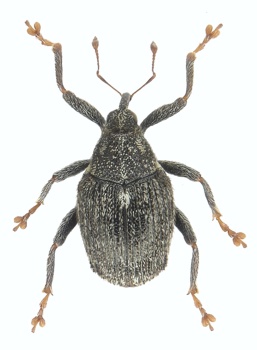Pests
Ceutorhynchus pallidactylus (Marsh.). - Cabbage Stem Weevil.
Systematic position.
Class Insecta, order Coleoptera, family Curculionidae, genus Ceutorhynchus Germar.Synonyms.
Ceutorhynchus quadridens Panz.; C. seriesetosus Dietz.Biological group.
Pest of seedlings and seed crops of cruciferous vegetables and rape.Morphology and biology.
Body length is 2.3-3.5 mm. Rostrum is long and slim. Each side of pronotum has toothlike prominence. Femora has small tooth; tarsal claw with denticle on its inner margin. Antennae and tarsi reddish, body pubescence consists of white and yellowish scales and long erected yellowish hairs. Longitudinal sulcus of pronotum covered with white scales. Elytra with small light spot behind scutellu; lower side of body with light vestiture.Distribution.
Europe, Northern Afrika, Asia Minor. Introduced to North America. In the former USSR, it is distributed in the European part from Transcaucasia northward to Baltic States and Karelia.Ecology.
Adults hibernate under litter in gardens and forest belts. Winter diapause terminates after soil temperature reaches about 8-9°C. Adult flies during warm days. Usually they feed on leafstalks and thick veins on the lower leaf surface, sometimes gnawing holes in the leaf. Oviposition lasts from the end of April to the beginning of May. Fertility is about 40 eggs being laid by 3-4 within cavities of leafstalks, stems or leaf mid-veins. Egg is transparent, ovate, 1.7 mm in length, and 0.5 mm in width. Leaf tissue expands around the eggs, resembling a wart. Embryogenesis lasts 4-7 days. Larva white in color, having 3 or (after Vasina, 1927) 5 instars. Body length of the mature larva is 5.3 mm; its head is large and yellowish. Larva gnaws gallery inside leafstalk toward stem. It moves downward along the stem, sometimes to a root collar, devouring the stem core. Sometimes up to 80 larvae inhabit one plant. Larva development finishes successfully inside abscised cabbage leaf. Larval stage lasts about 3 weeks. Pupation occurs inside soil cradle at a depth to 4.5 cm. Pupa develops after 2 weeks. Adult emerges in June-July. It feeds on cruciferous plants before hibernation. Population density depends in nature on the activity of entomophages; e.g., larval parasites Diospilus affinis Wsm. and larval predator Muscina stabulans Fallen.Economic significance.
Mainly during the larval stage, the pest damages cabbage and cauliflower seedlings and seed crops of cabbage, radish, garden radish, turnip, spring rape, garden turnip, and mustard. Its harming activity on seedlings begins inside greenhouses. Seed plants are infested by the pest soon after its bedding. At strong infestation of plants, seed yield decreases more than 2 times; seed germinating power decreases, too. Control measures include rejection of the infested cabbage seedlings before bedding and deep autumn plowing after harvesting. Insecticide treatment is necessary at high pest abundance soon after the pest's appearance, and then once or twice within 7-8 day interval.Reference citations:
Arzanov Yu.G. 1989. Ecological and faunistic review of the weevils (Coleoptera, Curculionidae) from the steppe and desert zones of Rostov region and Kalmykia. PhD Thesis. Leningrad: ZIN RAS, 24 p. (in Russian).Graham C.W. & Gould H.J. 1980. Cabbage weevil on spring oilseed rape in Southern England and its control. Annals of Applied Biology, 95 (1). Colchester & London: 1-10.
Ioannisiani T.G. 1972. The weevils (Coleoptera, Curculionidae) of Byelorussia. Minsk: Nauka i Tekhnika, 352 p. (in Russian).
Ismailova M.Sh. 1993. Ecological and faunistic review of the weevils (Coleoptera: Apionidae, Rhynchophoridae, Curculionidae) from the low-lying and submountain territories of Daghestan. PhD Thesis. St. Petersburg: ZIN RAS, 23 p. (in Russian).
Korotyaev B.A. 1989. Materials to the knowledge of Ceutorhynchinae (Coleoptera, Curculionidae) of Mongolia and the USSR. In: Scarlato O.A., ed. Insects of Mongolia (7). Leningrad: Nauka. P. 107-282 (in Russian).
Korotyaev B.A. & Cholokava A.O. 1989. A review of the weevil subfamily Ceutorhynchinae (Coleoptera, Curculionidae) of the fauna of Georgia. Entomol. obozr. 68(1): 154-177 (in Russian).
Poiras A.A. 1998. Catalogue of the weevils (Coleoptera, Curculionoidea) and their host plants in the Republic of Moldova. Pensoft Series Faunistica N 10. Sofia-Moscow: Pensoft Publishers. 156 p.
Polyakov I.Ya., Kopaneva L.M., Dorokhova G.I. 1982. Number of pests and entomophages of vegetable cultures and potato in different agricultural zones of the USSR. In: Kopaneva L.M., ed. Key to harmful and useful insects and mites of vegetable cultures and potato in the USSR. Leningrad: Kolos: 5-36 (in Russian).
Prasolov V.N. 2005. Weevils (Curculionoidea part.) of the Leningrad Region. http://www.zin.ru/Animalia/Coleoptera/Rus/Prasolov.htm (in Russian)
Shchegolev V.N., ed. 1955. Agricultural Entomology. Leningrad & Moscow: Sel.khozgiz. 616 p. (in Russian)
Silfverberg H. 1992. Enumeratio Coleopterorum Fennoscandiae, Daniae et Baltiae. Helsinki-Helsingfors: Helsingin Hyonteisvaihtoyhdistys, 94 p.
Vasina A.N. 1927. Ceutorrhynchus quadridens Panz. .pest of cruciferous plants. In: Proceedings of plant protection station (1). Moscow: Izd. Moskowskogo zem. otdela. P. 91-109 (in Russian).
Winfield A. 1961.Observations on the biology and control of the cabbage stem weevil, Ceutorhynchus quadridens (Panz.) on the trowse mustard (Brassica juncea). In: Pearson O., ed. Bulletin of Entomological research, 52 (3). London: P. 589-600.


